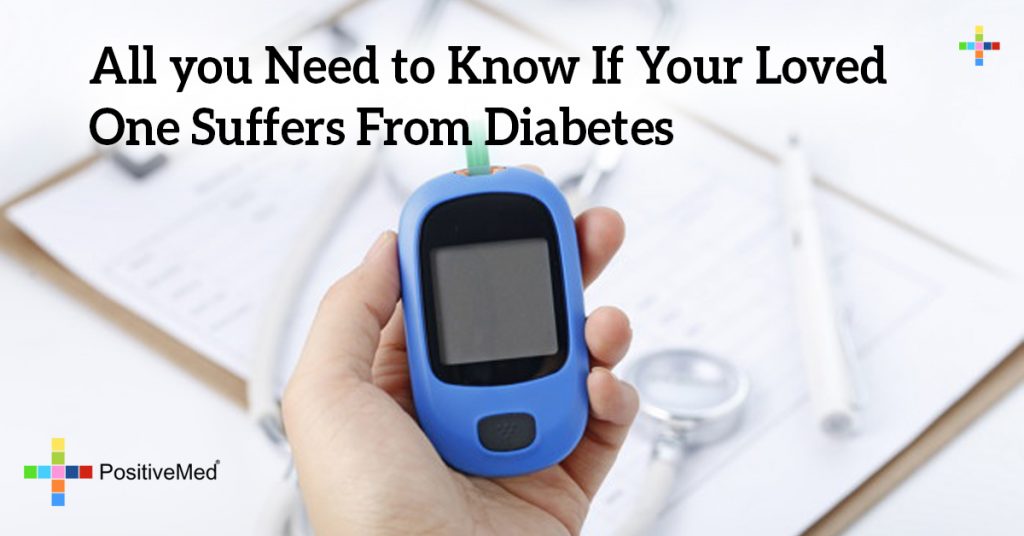
All you Need to Know If Your Loved One Suffers From Diabetes
[nextpage title=”…”]
Proper diabetes management can enable your loved one to live an active, happy life. You can help them make healthy choices and avoid disease complications. Following is vital information to aid you in offering support.

DIABETES DEFINED
Diabetes is a condition of persistently high blood sugar. There are two main classifications:
- Type 1 – The body doesn’t produce the hormone insulin. This regulating chemical moves sugar from carbohydrates into cells. Type 1 diabetes is caused by a faulty immune system. The body mistakenly destroys the cells that make insulin. Type 1 diabetes develops during childhood or young adulthood. To maintain normal blood sugar, insulin must be taken daily.
- Type 2 – The body doesn’t make enough insulin or doesn’t use it effectively. Symptoms typically arise in adulthood. Type 2 is the most common form of diabetes. Taking insulin isn’t always necessary. Type 2 is easier to manage with lifestyle choices.
In this article, we provide you with essential information regarding Type 2 diabetes.
COMPLICATIONS
Diabetes puts your loved one at risk for other medical conditions. These include:
- heart disease
- stroke
- impaired vision
- kidney disease
- nerve damage
- oral disease
- skin disorders
Let’s cover each of these potential complications and how they can be minimized.
HEART DISEASE AND STROKE
Diet
You can nudge your loved one to choose nutritious foods. To guard against heart disease and stroke, they should eat:
- high-fiber foods – fruit, vegetables, beans, and whole-grain bread and cereals
- heart-healthy fats – nuts, seeds, avocado, fish
- foods low in saturated fat – low-fat milk, cheese, and yogurt
- low-sodium foods
Advertisement:
[/nextpage][nextpage title=”…”]
Your loved one must keep an eagle eye on carbohydrates. A baseline number to aim for is 45 carbs per meal. Adjustments can be made based on results of glucose testing and medical advisement. Sugar-sweetened beverages should be avoided.
Eliminate Smoking
If your loved one smokes, you can help them quit. They can initiate the process by contacting a quit line. This is a smoking cessation service provided by phone. By calling a toll-free number, your loved one can speak with a trained counselor. The adviser will formulate a personalized cessation plan. The free assistance includes self-help materials and referral to a local clinic. Quit lines are sponsored by the US Department of Health and Human Services.
- The national quit line number is: 1-800-QUIT-NOW.
Exercise
Exercise makes the body more responsive to insulin. It takes less insulin to maintain blood sugar within the normal range. Physical activity moves sugar into cells and prevents it from lingering in blood.Here’s an exciting fact. Pairing a healthy diet with exercise can resolve diabetes! Together they render:
- improved blood sugar control
- reduced blood pressure and cholesterol
- revved circulation
- weight loss
- stress reduction
- strong muscles and bones
- heart health
RELATED ARTICLE: Gestational Diabetes and The Best Diet
Activity Guidelines
Frequency
Your loved one should aim to be active for at least 30 minutes daily. They can start off slowly with 10 minutes, and gradually increase the time. Alternatively, they can break up exercise into three stints of 10 minutes each. Safe forms of exercise are walking, swimming, dancing, bicycling, and yoga.
Testing
Blood sugar should be tested before and after exercise. This will reveal the activity’s effect on the body.
Caveats
The Cleveland Clinic recommends the following:
Exercise should be avoided when blood sugar is below or above the normal range. If blood sugar is low at the start of exercise, it can drop further, resulting in a hypoglycemic reaction. Indications are sweating, anxiety, shaking, headache, rapid pulse, weakness, confusion, and irritability.
A blood sugar level of less than 100 mg/dL is too low to exercise safely. A snack should precede activity. An ideal choice for 30 minutes of exercise is one with 15 grams of carbohydrate. Examples are:
- small piece of fruit
- 1 cup plain yogurt
- granola bar
- 1 cup skim milk
[/nextpage][nextpage title=”…”]
A glucose range to aim for prior to exercise is 100-250 mg/dL. A snack may also be required to sustain this range.
If exercise is done for an hour or more, a snack should contain both carbohydrates and protein. Protein slows down digestion and prolongs the benefit of carbs. Examples of snacks for more intense exercise are:
- 5 whole-grain crackers and 4 dice-sized cheese cubes
- 5 whole-grain crackers and 1 tablespoon peanut butter
- 1/4 cup cottage cheese with 1 cup fruit
- 1 rice cake with 1 tablespoon peanut butter
A glucose level of 300 mg/dL and above may be too high to exercise safely. This can result in hyperglycemia. The body ends up using fat to compensate for low insulin. Symptoms of hyperglycemia are increased thirst, blurry vision, fatigue, frequent urination, and headaches.
When hyperglycemia is not resolved, dangerous compounds called ketones form. If they accumulate in the blood, your loved one will feel very sick. Symptoms include nausea, vomiting, weakness, confusion, abdominal pain, and shortness of breath. At its worst, untreated hyperglycemia can lead to coma.
A doctor can determine the ideal blood sugar range for exercise. He can also advise the best type of activity based on whether your loved one has complications.
Regular Medical Exams
Ensure that your loved one is seen by a doctor at least every six months. It’s important to have the following monitored:
- cholesterol – harmful cholesterol can clog blood vessels, increasing the risk of heart attack and stroke.
- triglycerides – high blood fats can cause memory loss, skin lesions, abdominal pain, and pancreatitis.
- blood pressure – hypertension increases the workload on the heart. This can lead to a heart attack, stroke, kidney disease, and vision loss.
- A1C blood glucose – tracks blood sugar at 3-month intervals.
Your loved one should also receive a yearly flu vaccination. A pneumonia vaccine should be obtained for people age 65 and older. Only one lifetime pneumonia vaccination is required, without the need for booster shots. The exception to this is if the vaccine was already received before age 65. In that case, a booster shot is needed five years after the first inoculation. The Centers for Disease Control states that diabetes increases the risk of complications from flu and pneumonia.
For further protection, family members living with your loved one should also get vaccinated. The best time to receive a flu vaccine is in September. The shot takes about two weeks to confer protection. A pneumonia vaccine can be obtained at any time during the year.
Monitoring Blood Sugar
Most people with Type 2 diabetes need to test their blood glucose once or twice a day. Levels should be logged and brought to doctor appointments. As mentioned above, blood sugar should also be tested before and after exercise.
Medication
Ensure your loved one takes their medication as prescribed. Pill bottles should be easy to open. Alternatively, a pill organizer with an insulin pen is a helpful aid.
If insulin injections can’t be done independently, you can learn how to give them.
VISION PROBLEMS
High blood sugar can damage the eyes, impairing vision and potentially causing blindness. Help your loved one safeguard their vision by:
- maintaining normal blood glucose levels
- monitoring blood pressure daily
- eliminating smoking
- having annual eye exams by an ophthalmologist
Vision complications can develop unnoticed. This is why regular eye exams are vital. An ophthalmologist will check for:
- glaucoma – high ocular pressure can damage blood vessels that feed the optic nerve and retina. The retina is nerve tissue that generates visual impulses and transmits them to the brain.
- macular edema – the macula is part of the retina. It focuses fine details. If fluid from blood vessels leaks into the macula, it can swell. As a result, central vision is impaired. Objects appear blurred, wavy, or faded in color.
- cataract – clouding of the ocular lens, blocking light from entering the eye.
Emphasize that if your loved one has trouble seeing, they should tell you immediately. Symptoms of an urgent eye problem are:
- black spots
- flashes of light
- visual holes
- faint images
- blurry vision
KIDNEY DISEASE
High glucose can damage the blood vessels of the kidneys. This prevents them from properly cleaning the blood. Consequently, toxic waste materials accumulate. Water and salt are retained. Be on the watch for the following signs of kidney disease:
- ankle and leg swelling
- urinary tract infection
- frequent nighttime urination
- nausea and vomiting
- loss of appetite
- weakness and fatigue
- pallor
- itching
- muscle cramps
[/nextpage][nextpage title=”…”]
To protect your loved one from kidney complications, make sure they keep their glucose and blood pressure within normal ranges. They should also avoid taking over-the-counter pain medications, which can further harm the kidneys.
NERVE DAMAGE
Persistent high blood sugar can cause nerve damage, termed diabetic neuropathy. It most often affects the legs and feet. There are several different types of neuropathy. Symptoms include pain, numbness, digestive problems, and dizziness. A foot sore that’s not healing is a red flag. Other signs are burning, tingling, and weakness. If you observe any of these symptoms, take your loved one to the doctor.
ORAL DISEASE
Diabetes increases the risk of oral disease. One of the causes is reduced blood flow. When teeth and gums aren’t properly supplied with blood, they become weak and prone to infection. This predisposes your loved one to gum disease. You can help promote healthy gums and teeth by taking your loved one for regular dental check-ups. If their diabetes is well-controlled, they should see a dentist every six months. If gum disease is present, they should be examined every four months.
In addition, encourage vigilant home hygiene. Teeth should be brushed for two minutes twice a day with a fluoride toothpaste. The tongue should be brushed as well. Gums should be flossed daily. Check your loved one’s teeth once monthly, keeping your eyes peeled for a problem. Red flags are:
- gum inflammation – tissue may be red, tender, receding, or bleeding.
- sensitive teeth
- breath odor – fruity breath is a sign that diabetes is not well-controlled. Ammonia breath may signal kidney disease.
- thrush fungal infection – indicated by white lesions on the tongue, inner cheeks, roof of the mouth, or gums. There may be cracking and redness at the corners of the mouth. Additional signs are cotton mouth or loss of taste.
SKIN DISORDERS
Diabetes makes your loved one prone to skin disorders. These include infections, boils, styes, and carbuncles. Inflamed tissues are hot, red, swollen, and painful. A fungus is characterized by an itchy rash, blisters, and scales. It favors warm, moist skin folds. Examples are:
- between fingers and toes
- nails
- underarms
- groin
- under breasts
Most skin disorders are easily treated when caught early. Antibiotic creams and pills are the primary defense. Itchy skin is soothed with mild soap and lotion. Just make sure lotion is not applied between the toes. Sunscreen protection is needed against prolonged sun exposure. Any skin condition that is slow to heal should be brought to a doctor’s attention.
RELATED ARTICLE: What’s Diabetes?
Foot Care
Diabetic feet need TLC. They should be washed and dried daily. Examine them for sores and cuts. A podiatrist should be seen every two months if your loved one has neuropathy, loss of sensation in their feet, vascular disease, or a history of wounds or ulcers. It’s also wise to visit a podiatrist for periodic nail care. Lack of sensation in the feet is a major concern. Your loved one may be unaware they have an injury. Left untreated, it can become infected, ulcerated, or require amputation.
Walking barefoot should be avoided. Diabetic feet need low-heeled shoes that fit properly.
MEDICAL IDENTIFICATION BRACELET
The information on the bracelet should be concise. The word “Diabetes” should be prominently engraved on the bracelet face. The underside can provide other vital information, such as:
- insulin-dependent
- medication-controlled
- emergency contact number
- physician name
- directions to a source of further info, such as “See wallet card for full medical history.”
When selecting a bracelet, keep in mind that the simpler the design, the easier it will be for responders to see vital data.
Keep extra IDs on hand in case your loved one misplaces or loses a bracelet. Also, pack a second bracelet when traveling.
IN GOOD COMPANY
Tell your diabetic loved one they’re in good company. The following celebrities have Type 2 diabetes:
- Halle Berry
- Delta Burke
- Paula Deen
- Salma Hayek
- Tom Hanks
Diabetes needn’t be disheartening. By being proactive, life can be enjoyed to the full.
[/nextpage]





